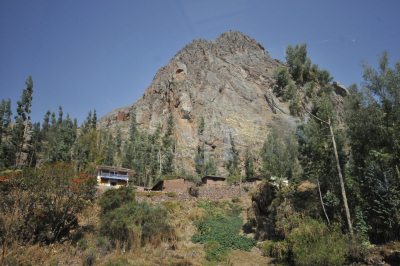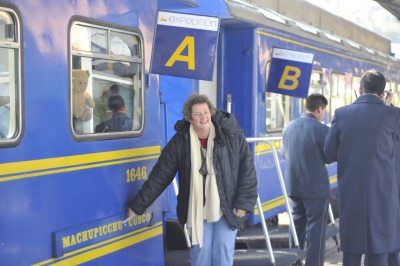Train from Cuzco

|
Train from Cuzco to Machu Picchu - Backpacker
Class
We were picked up at the hotel at ten to seven, walked down the road to the minibus on the corner. Earliest I have ever been offered the choice of AA Duracell batteries, snap shackles and hats from a lady seller. Poroy a twenty minute journey away from Cuzco saw us passing loads of buses being loaded with trekkers, backpackers and campers. Poroy Station is at eleven thousand four hundred and thirty eight feet. Some of the side roads in the town made the Hovis Hill look like a tiny slope. We were dropped at the station, welcomed by ladies in traditional dress selling water.  
The Backpacker trains are the most economical way to travel on the route between Cuzco - Poroy Station and Aguas Calientes - the town below Machu Picchu, travelling through the Sacred Valley of the Incas, via Ollantaytambo our next stop after Machu Picchu. This service is advertised as being "ideal for our adventure passengers or for those seeking comfort and security, without all the frills. These carriages offer travelers a true Peruvian experience. Seats are upholstered with indigenous fabrics, giving a touch of local flavour". Inside our carriage 'A' we settled our bags on the rack and sat at our seats with table. At eight twenty five we were given a packet of savoury sticks, a couple of really tasty biscuits and a choice of beverage.   Journey: Our journey begins by descending into the Sacred Valley of the Incas, passing by lush, green fields and colourful villages in the foothills of the Andes. After departing Poroy and going through Cachimayo, the train descends to the plateau of Anta, a patchwork landscape of typical Andean crops and passes lush fields and colourful villages in the foothills of the Andes.   Far to the left, just below the horizon, the massive agricultural terraces of Jaquijahuana can be seen, close to the village of Zurite. Sadly, these great terraces are all that remain today of what was once a major Inca city, lost forever during the first years after the Spanish conquest. Beyond the town of Huarocondo the great plain narrows dramatically as the track enters a deep gorge carved by the rushing Pomatales River down which the railway, too, is funneled until it meets the Urubamba River, which runs through the beautiful Sacred Valley of the Incas. For the first time we were on a train that had to do a figure Z to drop twenty feet or so. The train stopped backed up, forward down to a lower track and repeated the process.  
The train passes through extensive areas of terracing dotted with the ruins of Inca fortresses. Bisecting this are still-visible sections of an ancient, long-abandoned highway adopted by the muleteers of the late 19th century, who used it to travel between Cusco and the rubber plantations of the Amazon lowlands. Five kilometers beyond Pachar, is the village of Ollantaytambo (two thousand six hundred meters) where farmers work with the same patience and skill that their ancestors must have employed to shape and then move the huge blocks of stone with which they built both their homes and the temples in which they worshipped. We arrived here at nine twenty.   As the train leaves Ollantaytambo to begin the last part of its journey to Aguas Calientes, the railway follows the river into the Urubamba Gorge. At Coriwaynachina, known simply to the generations of hikers who have begun the Inca Trail there as Km 88, a fine staircase carved into the rock leads to a series of ruined buildings where once, it is said, Inca artisans took advantage of the constant wind that rises from the valley floor to smelt gold. Emerging from a short tunnel, a series of beautiful agricultural terraces marks the ruins of Qente, which in Quechua means hummingbird. In this fertile microclimate fed by a nearby waterfall, giant hummingbirds are indeed a common sight in the early morning and bright flowers bloom all year round. The last part of the journey was through sheer mountains with snow caps.  Surrounded by tall ceibos and rocky outcrops hung with orchids and bromeliads, the train passes Km 104 at Chachabamba, from where the one-day trek to Machu Picchu via the magnificent ruins of Wiñay Wayna begins. At just two km from the Inca Remains, the train arrives at Machu Picchu Town. Surrounded by the high, green mountains that cradle the famous lost city, as well as myriad other Inca remains, this small town, which is well known for its thermal baths - we were told Icy Water and that was the end of that - has blossomed into a popular overnight destination for travelers to Machu Picchu. A very different town with more pizza restaurants than we have ever seen before. 
ALL IN ALL THE JOURNEY WAS A TASTE OF WHAT WAS TO COME INCREDIBLY EXCITING |






